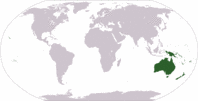Clinosperma bracteale
| Clinosperma (klih-no-SPURM-ah) bracteale (brak-teh-ALL-eh) | |||||||
|---|---|---|---|---|---|---|---|
 Location: 900 m Tontouta, 2004. New Caledonia. | |||||||
| Scientific Classification | |||||||
| |||||||
| Synonyms | |||||||
|
| |||||||
| Native Continent | |||||||
|
| |||||||
| Morphology | |||||||
| |||||||
| Culture | |||||||
|
| |||||||
| Survivability index | |||||||
|
| |||||||
| Common names | |||||||
|
| |||||||
Contents
Habitat and Distribution
Clinosperma bracteale is found in rainforests, between sea level and 1200 m (3900 ft.), in central and southern New Caledonia.Description
This species forms a slender, ringed trunk, which holds a whitish crownshaft, and a rather sparse crown, of spreading, leathery leaves. A solitary-trunked palm which grows up to 15 m tall, at a uniform 10 cm width. The gray to tan trunks, are ringed by leaf scars up to the unusual, 60 cm tall crownshaft, holding 12 - 15 pinnate leaves. At the base, the crownshaft bulges significantly to one side, giving it a distinct triangle shape. It is usually covered in a hairy tomentum as well as white wax and, depending on the concentration of each, may be brown to green to white in color. Each leaf, recurving at its end, is 1.5 m long on 30 cm petioles being light to bright green in color. The stiff pinnae are once-folded with a prominent midrib, 90 cm long, and regularly arranged along the rachis. The infrafoliar inflorescence produces small, white to yellow, unisexual flowers on bright red branches, basally divided to three orders and distally to one. The female flowers are nearly twice as long as the male's, both contain three distinct sepals and petals, the former with 3 staminodes, the latter with 6 stamens. The globose fruit ripen from shiny green to black, each with one light brown seed.The inflorescence unfolds in a bright red color. Phenology (flower): Flowers arranged in triads (1 female, surrounded by 2 males), on more or less branched inflorescences, the leaves are well below. Fruit globose or ellipsoid with the stigmatic residue in basal or lateral position. (Smithsonian Tropical Institute) Editing by edric.
Culture
It is one of the most adaptable of the island's magnificent palms, and even though it is rather widespread on its native island, in cultivation it is extremely rare, foremost perhaps because of the difficulty in obtaining ripe seeds. It should adapt well to many tropical and warm temperate climates. Virtually unknown in cultivation.
In cultivation it is extremely rare, foremost perhaps because of the difficulty in obtaining ripe seeds. It should adapt well to many tropical and warm temperate climates. (RPS.com), edric.
Comments and Curiosities
This very slender palm from rainforests between sea level and 1200 m (3900 ft.) in central and southern New Caledonia forms a slender, ringed trunk, which holds a whitish crownshaft and a rather sparse crown of spreading, leathery leaves. The inflorescence unfolds in a bright red color. It is one of the most adaptable of the island's magnificent palms, and even though it is rather widespread on its native island. (RPS.com), edric.
- IMAGE GALLERY
External Links
- Glossary of Palm Terms
- MODERN BOTANICAL LATIN
- "Just To Be Clear"
- http://nzpalmandcycad.com/?pg=96
- http://southeastgarden.com/new-caledonia.html
- New Caledonia photos in habitat.
References
Phonetic spelling of Latin names by edric.
Special thanks to Geoff Stein, (Palmbob) for his hundreds of photos.
Special thanks to Palmweb.org, Dr. John Dransfield, Dr. Bill Baker & team, for their volumes of information and photos.
Glossary of Palm Terms; Based on the glossary in Dransfield, J., N.W. Uhl, C.B. Asmussen-Lange, W.J. Baker, M.M. Harley & C.E. Lewis. 2008. Genera Palmarum - Evolution and Classification of the Palms. Royal Botanic Gardens, Kew. All images copyright of the artists and photographers (see images for credits).
Many Special Thanks to Ed Vaile for his long hours of tireless editing and numerous contributions.























